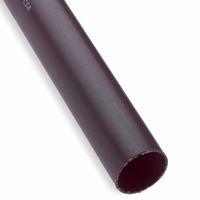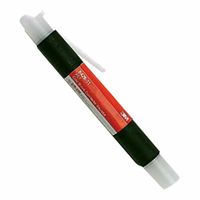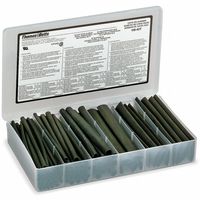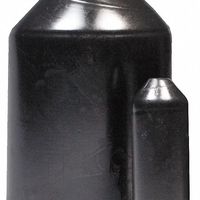Call +(254) 703 030 000 / 751 483 999 / 721 704 777
- Home
- Electrical
- Wire Cable Management
- Heat Shrink Cold Shrink Tubing
.....Read More
Frequently Asked Questions
What is the difference between heat shrink and cold shrink tubing?
Heat shrink and cold shrink tubing are both used for insulating, protecting, and sealing cables and connections, but they differ in application and material properties.
Heat Shrink Tubing:
- **Material**: Made from thermoplastic materials like polyolefin.
- **Application**: Requires a heat source, such as a heat gun or torch, to shrink the tubing. The heat causes the material to contract and form a tight seal around the object.
- **Properties**: Offers a wide range of shrink ratios, typically from 2:1 to 6:1, allowing it to fit over various sizes before shrinking.
- **Advantages**: Provides a durable, long-lasting seal that is resistant to environmental factors like moisture, chemicals, and abrasion.
- **Limitations**: Requires access to a heat source, which may not be feasible in all environments or for all users.
Cold Shrink Tubing:
- **Material**: Made from elastomeric materials like silicone rubber or EPDM.
- **Application**: Pre-expanded and held in place by a removable core. Once the core is removed, the tubing contracts to form a seal.
- **Properties**: Does not require heat for installation, making it ideal for environments where heat application is impractical or unsafe.
- **Advantages**: Quick and easy to install, especially in confined spaces or hazardous environments. Provides excellent insulation and is resistant to UV, ozone, and weathering.
- **Limitations**: Limited shrink ratios compared to heat shrink, and may not provide as tight a seal in some applications.
In summary, the choice between heat shrink and cold shrink tubing depends on the specific application requirements, environmental conditions, and available resources.
How do you install heat shrink tubing?
1. **Select the Right Size**: Choose heat shrink tubing with a diameter slightly larger than the object it will cover. Ensure it shrinks to a snug fit.
2. **Cut to Length**: Measure and cut the tubing to the desired length using scissors or a sharp blade. Ensure it covers the area completely.
3. **Slide Over the Object**: Place the tubing over the wire, cable, or object. Ensure it is positioned correctly before heating.
4. **Prepare Heat Source**: Use a heat gun, hairdryer, or lighter. A heat gun is preferred for even heating and control.
5. **Apply Heat Evenly**: Hold the heat source a few inches away from the tubing. Move it back and forth evenly to avoid overheating or burning. Rotate the object if necessary for uniform shrinkage.
6. **Observe Shrinkage**: Watch as the tubing shrinks and conforms to the shape of the object. Ensure there are no air bubbles or gaps.
7. **Allow to Cool**: Once fully shrunk, let the tubing cool and set. This ensures a tight, secure fit.
8. **Inspect the Fit**: Check for complete coverage and a snug fit. Reapply heat if necessary for any missed areas.
9. **Finish Up**: Trim any excess tubing if needed. Ensure the tubing is secure and not easily moved.
10. **Safety Precautions**: Wear gloves and safety glasses to protect from heat and sharp tools. Work in a well-ventilated area to avoid inhaling fumes.
What are the applications of heat shrink tubing?
Heat shrink tubing is a versatile material used in various applications across multiple industries. Its primary function is to provide insulation, protection, and strain relief for wires and cables. Here are some key applications:
1. **Electrical Insulation**: Heat shrink tubing is widely used to insulate wires, preventing electrical shorts and protecting against environmental factors like moisture and dust.
2. **Cable Strain Relief**: It provides mechanical support to cables, reducing stress and preventing damage at connection points, especially in environments with frequent movement or vibration.
3. **Wire Bundling**: It helps organize and bundle multiple wires together, improving aesthetics and reducing clutter in electrical panels and equipment.
4. **Environmental Protection**: Heat shrink tubing offers protection against chemicals, abrasion, and UV radiation, making it ideal for outdoor and harsh environment applications.
5. **Repair and Maintenance**: It is used to repair damaged insulation on wires and cables, restoring functionality and safety without the need for complete replacement.
6. **Color Coding and Identification**: Available in various colors, heat shrink tubing is used for color-coding wires and cables, aiding in identification and organization.
7. **Connector Sealing**: It provides a seal around connectors, preventing moisture ingress and ensuring reliable connections in automotive, marine, and aerospace applications.
8. **Medical Devices**: In the medical field, heat shrink tubing is used to insulate and protect components in medical devices, ensuring safety and reliability.
9. **Automotive Applications**: It is used in automotive wiring harnesses to protect against heat, chemicals, and abrasion, ensuring long-term reliability.
10. **Aerospace and Defense**: Heat shrink tubing is used in aerospace and defense applications for its lightweight, durable, and flame-retardant properties, essential for safety and performance.
These applications highlight the adaptability and essential role of heat shrink tubing in ensuring the safety, efficiency, and longevity of electrical and mechanical systems.
How do you choose the right size of heat shrink tubing?
To choose the right size of heat shrink tubing, follow these steps:
1. **Measure the Diameter**: Determine the diameter of the object you need to cover. Use a caliper or a ruler to measure the widest part of the object.
2. **Shrink Ratio**: Understand the shrink ratio of the tubing, which indicates how much the tubing will shrink when heated. Common ratios are 2:1, 3:1, and 4:1. A 2:1 ratio means the tubing will shrink to half its original diameter.
3. **Select the Tubing Size**: Choose a tubing size that is slightly larger than the widest part of the object before shrinking. For example, if the object is 5mm in diameter and you are using a 2:1 shrink ratio, select tubing with an initial diameter of at least 10mm.
4. **Wall Thickness**: Consider the wall thickness after shrinking, as it affects durability and insulation. Thicker walls provide more protection but may be less flexible.
5. **Length**: Ensure the tubing is long enough to cover the entire area, accounting for any shrinkage in length during the process.
6. **Material and Environment**: Choose a material suitable for the environment. For example, polyolefin is common for general use, while fluoropolymer is better for high-temperature applications.
7. **Color and Features**: Consider color for coding purposes and any additional features like adhesive lining for better sealing.
8. **Test Fit**: Before final application, test fit a small piece to ensure it shrinks properly and fits securely.
By following these steps, you can select the appropriate heat shrink tubing for your specific application, ensuring effective insulation and protection.
What materials are heat shrink tubing made from?
Heat shrink tubing is made from a variety of materials, each offering distinct properties suitable for different applications. The most common materials include:
1. **Polyolefin**: This is the most widely used material for heat shrink tubing. It offers excellent chemical, electrical, and physical properties, making it suitable for a broad range of applications. Polyolefin tubing is flexible, flame-retardant, and can withstand high temperatures.
2. **PVC (Polyvinyl Chloride)**: Known for its good electrical insulation properties, PVC heat shrink tubing is often used in applications where flexibility and flame resistance are required. It is also resistant to abrasion and chemicals.
3. **PTFE (Polytetrafluoroethylene)**: PTFE tubing is used in high-temperature applications due to its ability to withstand extreme temperatures and its excellent chemical resistance. It is also non-flammable and has a low coefficient of friction.
4. **FEP (Fluorinated Ethylene Propylene)**: Similar to PTFE, FEP offers high-temperature resistance and excellent chemical resistance. It is often used in applications requiring clarity and flexibility.
5. **Elastomeric**: This type of tubing is made from rubber-like materials, providing excellent flexibility and elasticity. It is often used in environments where resistance to oils, fuels, and other chemicals is necessary.
6. **Silicone**: Known for its high-temperature resistance and flexibility, silicone heat shrink tubing is used in applications where extreme temperature variations are present.
7. **PVDF (Polyvinylidene Fluoride)**: PVDF tubing offers high abrasion resistance and is used in applications requiring high mechanical strength and chemical resistance.
Each material provides specific benefits, making heat shrink tubing versatile for various industrial, commercial, and consumer applications.
How do you remove heat shrink tubing?
To remove heat shrink tubing, follow these steps:
1. **Safety First**: Ensure the power is off and the device is unplugged. Wear safety goggles and gloves to protect against sharp tools and hot surfaces.
2. **Identify the Area**: Locate the section of the heat shrink tubing you need to remove. Ensure you have clear access to the area.
3. **Use a Sharp Tool**: Carefully use a utility knife or a pair of sharp scissors. Position the blade at one end of the tubing, taking care not to damage the underlying wires or components.
4. **Make a Small Incision**: Gently make a small incision along the length of the tubing. Avoid cutting too deep to prevent damage to the wires or components beneath.
5. **Peel Back the Tubing**: Once the incision is made, use your fingers or a pair of needle-nose pliers to peel back the tubing. Start from the incision and work your way along the length of the tubing.
6. **Remove the Tubing**: Continue peeling until the tubing is completely removed from the wires or components. If the tubing is stubborn, make additional small incisions as needed.
7. **Inspect the Area**: After removal, inspect the wires and components for any damage. Ensure that no residue or small pieces of tubing remain.
8. **Clean Up**: Dispose of the removed tubing properly. Clean the area if necessary to remove any adhesive residue.
9. **Reapply if Needed**: If you need to replace the tubing, cut a new piece of heat shrink tubing to the appropriate length and apply it using a heat gun or lighter, ensuring it shrinks evenly around the wires or components.
By following these steps, you can safely and effectively remove heat shrink tubing without causing damage to the underlying materials.
What are the benefits of using adhesive-lined heat shrink tubing?
Adhesive-lined heat shrink tubing offers several benefits, making it a versatile and reliable choice for various applications:
1. **Enhanced Sealing**: The adhesive lining provides a watertight and airtight seal, protecting against moisture, dust, and other environmental contaminants. This is particularly beneficial in outdoor or harsh environments.
2. **Improved Insulation**: It offers excellent electrical insulation, reducing the risk of short circuits and electrical failures. This makes it ideal for use in electrical and electronic applications.
3. **Mechanical Protection**: The tubing provides robust mechanical protection, safeguarding wires and cables from abrasion, cuts, and impacts. This extends the lifespan of the components it covers.
4. **Corrosion Resistance**: The adhesive lining helps prevent corrosion by sealing out corrosive elements, which is crucial in automotive, marine, and industrial settings.
5. **Strain Relief**: It offers strain relief at connection points, reducing the risk of damage due to bending or pulling, which is essential for maintaining the integrity of electrical connections.
6. **Versatility**: Available in various sizes, colors, and shrink ratios, adhesive-lined heat shrink tubing can accommodate a wide range of applications, from small electronic components to large cable assemblies.
7. **Ease of Use**: The tubing is easy to apply with a heat gun, allowing for quick and efficient installation. The adhesive activates and bonds as the tubing shrinks, ensuring a secure fit.
8. **Aesthetic Appeal**: It provides a neat and professional appearance, organizing and bundling wires and cables while concealing unsightly connections.
9. **Chemical Resistance**: The tubing is resistant to a variety of chemicals, oils, and solvents, making it suitable for use in chemically aggressive environments.
10. **Cost-Effectiveness**: By protecting components and extending their service life, adhesive-lined heat shrink tubing can reduce maintenance costs and downtime, offering long-term savings.





